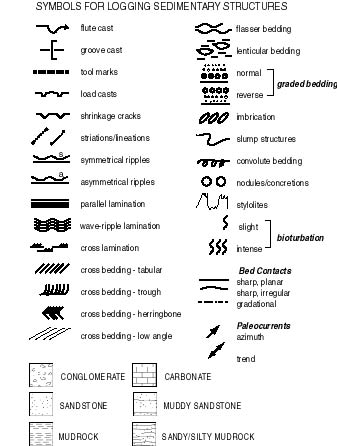The hcs like structures are composed of stacked lamina sets that thin and thicken within each bedset with successive lamina sets separated by muddy partings.
Planar lamination in stratigraphic column.
The point bar of the river will produce current ripple lamination due to the finer sediment and slower flow speeds.
Look for sedimentary structures that are characteristic of a specific environment or process examples.
These laminations can be related to solitary or stacked trough crossbeds st or planar crossbeds sp fig.
Look for sedimentary structures that are characteristic of a specific environment or process.
As the river migrates towards the direction of the eroding bank the current ripples of the point bar will end up being deposited on top of planar lamination dune cross stratification of the bank.
4 a shows a large scale planar lamination partially cut by the drill core.
Planar lamination step 4.
If you hypothesized that set of a fining upward sandstones were turbidites which have planar lamination and current ripple cross lamination but there is also trough cross stratification in a number of the beds ask yourself if there is a way for trough cross stratification to form in turbidites.
Evaluate how the vertical sequence of sedimentary structures changes to refine or.
Here is an outline of how to approach interpreting the depositional environment represented by a stratigraphic column.
Turbidites vs river channel deposits.
Through transect of exposed strata along the coppermine river.
Bed thickness is highly variable.
The sedimentary structures which result are roughly horizontal units composed of inclined layers.
The coarser grained areas that result from a faster flow speed will have upper planar lamination or dune cross stratification.
When developed some slightly curved or planar lamination foresets may be observed with no evidence of clear grain size sorting.
In geology cross bedding also known as cross stratification is layering within a stratum and at an angle to the main bedding plane.
Which displays a faint planar lamination disrupted by polygonal fractures.
Interpreting stratigraphic columns step 1.
Planar lamination step 4.
Primary structures include planar lamination and sporadic small scale cross lamination.
Most sandstone beds are medium grained and display planar lamination with well developed parting lineations large scale hummocky cross stratification like structures hcs.
The original depositional layering is tilted such tilting not being the result of post depositional deformation cross beds or sets are the groups of inclined.
Evaluate how the vertical sequence of sedimentary structures changes to refine or correct your environmental interpretations.
Generalized stratigraphic column of the husky creek fm.
6c and symmetrical to slightly asymmetrical ripple bedforms and cross lamination.









